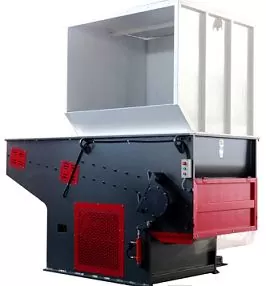Thick plastic is the kind of challenge that makes recycling lines sweat. If you’ve ever tried to process heavy plastic blocks, sheets, or industrial scraps, you know what I mean. The problem? Ordinary shredders just choke. The pain is real—production stops, blades dull, motors overheat, and operators curse. But what if the right shredder could turn that frustration into clean, uniform flakes ready for reuse?
Yes, a shredder can handle thick plastic—but not every shredder. It depends on torque, blade design, motor power, and cooling systems. Industrial-grade machines like our Amige single-shaft models are built for dense, rigid plastics like HDPE blocks or thick PP sheets. With proper configuration, thick plastic becomes manageable, even routine.
That’s the short version. Now, let’s dig deeper into the engineering and experience behind that confident “yes.”

What makes thick plastic so hard to shred?
Thick plastic isn’t just bulk—it’s density and structure. Materials like HDPE, PP, or ABS in thick forms absorb impact energy instead of breaking easily. They flex before fracturing, generating resistance.
Many small shredders run into two core issues: insufficient torque and blade wear. When torque is too low, the motor stalls; when blades are too thin, they blunt fast. According to Single Shaft Shredder Machine For LDPE Film, torque and blade material are the top two limiting factors in processing thick plastic.
That’s why, in industrial settings, we use slow-speed, high-torque single-shaft shredders. They crush rather than slice.
How do industrial shredders manage thick plastic?
The secret lies in mechanical leverage. A robust shredder applies continuous torque through a gear-driven system, not high-speed cutting. The heavy-duty shafts rotate slowly but with immense force, pulling thick plastic inward and fracturing it.
Our Amige models use alloy steel blades, precision-ground for both hardness and resilience. The single shafts counter-rotate, gripping and compressing even large plastic lumps. When combined with a 75–150 kW motor and smart PLC control, the shredder adjusts torque automatically to prevent jamming.
In other words, it’s controlled brute force—power with purpose.
What types of thick plastic can be shredded?
Here’s where most people are surprised: thick doesn’t always mean unshreddable. We regularly process materials such as:
- HDPE blocks from machining waste
- PP sheet leftovers from thermoforming
- ABS housings from electronics
- PVC pipes and profiles
- PET preform defects
A Plastic shredder with plastic crusher line for lump recycling shows that 85% of post-industrial thick plastic waste can be shredded using torque-optimized single-shaft systems. The rest usually requires pre-crushing or manual cutting before feeding.
In short: if it fits in the hopper, it can be shredded—with the right equipment.
What are the key specifications for shredding thick plastic?
Four numbers tell the story:
- Torque: Minimum 20,000–40,000 Nm for dense plastics.
- Blade thickness: 20–30 mm for optimal bite.
- Motor power: 75–200 kW depending on throughput.
- Rotation speed: 50–80 rpm for controlled tearing.
Higher torque prevents stalling. Thicker blades resist deformation. Lower speed ensures uniform particle size and reduces noise. As an operator, I always say—don’t chase speed, chase consistency.
Single Shaft Shredder Machine For Rigid Material backs this up: shredders tuned for torque outperform high-speed types by 30% in handling thick materials.
Can shredding thick plastic damage the machine?
Yes—if done wrong. Overloading or feeding unprepared material (e.g., metal-contaminated plastics) can crack blades or overload the gearbox. But smart systems prevent this.
At Amige, we integrate overload sensors, automatic reverse rotation, and hydraulic pusher controls. When torque spikes, the system reverses automatically, freeing the jam before it causes damage.
Maintenance also matters. Regular greasing, blade rotation, and timely replacement prevent wear from becoming failure. In my plant, we schedule blade inspections every 300 working hours. It’s cheaper than downtime.
What role does cooling play when shredding thick plastic?
Friction generates heat. Heat softens plastic. Soft plastic smears instead of shreds. The solution: cooling systems.
Some of our high-capacity models use water-cooled bearings or airflow systems around the cutting chamber. This maintains temperature stability during long runs. According to Shredder Crusher Production Line For Plastic Lumps Recycling, cooling can increase throughput by 18% for thick HDPE.
So yes, even the humble cooling fan is a hero in thick plastic shredding.
Is pre-shredding or crushing required?
For extremely thick or irregular shapes, yes. Imagine a 200 mm solid HDPE slab—it’s like feeding a car door into a toaster.
Pre-crushers or guillotine cutters reduce bulk into manageable sizes. Once the chunks fit the hopper, the main shredder takes over. This two-step process balances safety and efficiency.
We often design integrated systems combining a crusher + shredder + conveyor, creating continuous flow. Plastic Lumps Shredding found that such systems reduce total energy use by 22%.
What should buyers look for when choosing a shredder for thick plastic?
Focus on the fundamentals:
- Torque over speed
- Solid gearbox construction
- Easy maintenance access
- Customizable blade sets
- Reliable supplier support
I often tell new buyers: “Don’t buy the biggest motor—buy the smartest torque.” Look for manufacturers who can adapt to your material mix, not just sell standard machines.
At Amige, we customize shredders based on plastic type, size, and hardness. Each line we build is tested with actual customer samples. That’s the difference between theory and reality.
Conclusion
Thick plastic isn’t a problem—it’s an opportunity. With a proper shredder setup, high torque, and regular maintenance, it becomes just another step in sustainable recycling.
Yes, a shredder can handle thick plastic—if you let engineering, not luck, lead the way.
